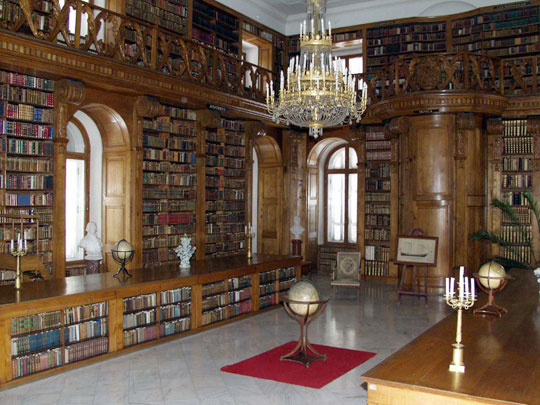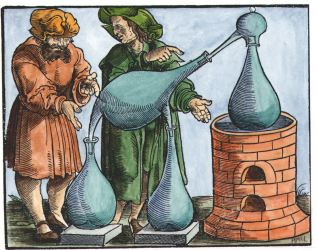| Author | Post |
|---|
adammclean
Member

| Joined: | Fri Sep 14th, 2007 |
| Location: | United Kingdom |
| Posts: | 606 |
| Status: |
Offline
|
|
Posted: Mon Apr 12th, 2010 10:12 am |
|
Does anyone know if a set of rituals and descriptions of the grades in the alchemically inspired order of the Golden and Rosy Cross which emerged in Germany in the 18th century has survived in a manuscript?
A number of books have been published on this theme over the last decades but these tend to give summaries and speculative accounts, so it would be good to see the original source material in its entirely.
|
Paul Ferguson
Member

| Joined: | Fri Feb 15th, 2008 |
| Location: | |
| Posts: | 1538 |
| Status: |
Offline
|
|
Posted: Mon Apr 12th, 2010 04:21 pm |
|
'A Czech manuscript of 1761...contains seven grades and rituals of the Gold- und Rosenkreutz'.
Hereward Tilton, in 'The Quest for the Phoenix' Vol. 88, page 251, quoting Christopher McIntosh, 'The Rose Cross and the Age of Reason', page 33-34.
|
adammclean
Member

| Joined: | Fri Sep 14th, 2007 |
| Location: | United Kingdom |
| Posts: | 606 |
| Status: |
Offline
|
|
Posted: Mon Apr 12th, 2010 04:53 pm |
|
I think this reference by Tilton could be a bit jumbled.
McIntosh on page 33 was referring to the Testamentum der Fraternitet Roseae et Aureae Crucis Codex 2897 in the National Library of Austria in Vienna.
Tilton on page 251 refers to a Czech manuscript dated 1761 which was discovered in Hungary in the late 19th century by Ludwig Abafi (Aigner). This was a document of a "Prager Assemblee" and was entitled Aureum Vellus seu Iunioratus Fratrum Rosae Crucis. Apparently this was in the Degh collection in the Castle of the Festetics family.
Where it is now I do not know - possibly in some public or University library in Hungary.
Last edited on Mon Apr 12th, 2010 07:52 pm by adammclean
|
Paul Ferguson
Member

| Joined: | Fri Feb 15th, 2008 |
| Location: | |
| Posts: | 1538 |
| Status: |
Offline
|
|
Posted: Mon Apr 12th, 2010 05:11 pm |
|
adammclean wrote: I think this reference by Tolton could be a bit jumbled.
McIntosh on page 33 was referring to the Testamentum der Fraternitet Roseae et Aureae Crucis Codex 2897 in the National Library of Austria in Vienna.
Tilton on page 251 refers to a Czech manuscript dated 1761 which was discovered in Hungary in the late 19th century by Ludwig Abafi (Aigner). This was a document of a "Prager Assemblee" and was entitled Aureum Vellus seu Iunioratus Fratrum Rosae Crucis. Apparently this was in the Degh collection in the Castle of the Festetics family.
Where it is now I do not know - possibly in some public or University library in Hungary.
My bad... See pp. 46-47 of McIntosh! 
Paul
|
Paul Ferguson
Member

| Joined: | Fri Feb 15th, 2008 |
| Location: | |
| Posts: | 1538 |
| Status: |
Offline
|
|
Posted: Mon Apr 12th, 2010 07:40 pm |
|
Is there anything in Bernhard Beyer's book?
http://www.angewandtemagie.com/buecher/themen/rosenkreuzer/das.html
"Der Autor, einer der profiliertesten Vertreter und besten Kenner maurerischer Systeme, gibt in diesem äußerst wertvollen Buch die Beschreibung der neun Grade, der verschiedenen Geheimschriften, der maurerischen Handlungen und Hieroglyphen der Gold- und Rosenkreuzer wieder."
This book is mentioned in:
Renko Geffarth: Religion Und Arkane Hierarchie: Der Orden Der Gold- Und Rosenkreuzer Als Geheime Kirche Im 18. Jahrhundert
and in Joana Peters' thesis:
http://www.grin.com/e-book/77903/historische-und-strukturelle-entwicklung-des-rosenkreuzerordens?partnerid=googlebooks
The present whereabouts of the manuscript might be mentioned in:
Horst Möller: Die Bruderschaft der Gold- und Rosenkreuzer. Struktur, Zielsetzung und Wirkung einer anti-aufklärerischen Gesellschaft, in: Helmut Reinalter [Hg.]: Freimaurer und Geheimbünde im 18. Jahrhundert in Europa, Frankfurt am Main 1989Last edited on Mon Apr 12th, 2010 08:16 pm by Paul Ferguson
|
Carl Lavoie
Member
| Joined: | Wed Feb 25th, 2009 |
| Location: | Canada |
| Posts: | 215 |
| Status: |
Offline
|
|
Posted: Tue Apr 13th, 2010 08:59 pm |
|
.
A paper by Antoine Faivre offers a useful and comprehensive outlook at various theses regarding the Rose-Croix d’Or. Nothing about manuscripts and their locations, however.
But he describes R. C. Zimmermann's study as «le meilleur travail jamais paru sur les Rose-Croix d'Or au XVIIIè siècle.»
Antoine Faivre, « Rose-Croix et Rose-Croix d’Or en Allemagne de 1600 1786, » pp.. 57-70 in Revue de l’histoire des religions, Paris PUF, Avril, 1972.
(Text reprinted in pp. 227-229 in Antoine Faivre, Mystiques, théosophes et Illuminés au si cles des Lumières, Hildesheim, Olms, 1977.)
See pp. 64 to 69.
http://www.persee.fr/web/revues/home/prescript/article/rhr_0035-1423_1972_num_181_1_9808?_Prescripts_Search_isPortletOuvrage=false
.
Last edited on Tue Apr 13th, 2010 09:04 pm by Carl Lavoie
|
Paul Ferguson
Member

| Joined: | Fri Feb 15th, 2008 |
| Location: | |
| Posts: | 1538 |
| Status: |
Offline
|
|
Posted: Tue Apr 13th, 2010 09:38 pm |
|
adammclean wrote:
I think this reference by Tilton could be a bit jumbled.
McIntosh on page 33 was referring to the Testamentum der Fraternitet Roseae et Aureae Crucis Codex 2897 in the National Library of Austria in Vienna.
Tilton on page 251 refers to a Czech manuscript dated 1761 which was discovered in Hungary in the late 19th century by Ludwig Abafi (Aigner). This was a document of a "Prager Assemblee" and was entitled Aureum Vellus seu Iunioratus Fratrum Rosae Crucis. Apparently this was in the Degh collection in the Castle of the Festetics family.
Where it is now I do not know - possibly in some public or University library in Hungary.
Could well be still at the Festetics. The director is László Czoma, e-mail:
khelikon AT freemail DOT hu
"The highlights of the palace are a gilt, mirrored ballroom and the Helikon Library, a masterpiece of joinery by János Kerbl, built in 1801 and containing over 90,000 books in diverse languages, the oldest of which – Chronica Hungarorum – dates back to 1488." (from the 'Rough Guide to Hungary').Attached Image (viewed 3925 times):
 Last edited on Tue Apr 13th, 2010 09:45 pm by Paul Ferguson
|
adammclean
Member

| Joined: | Fri Sep 14th, 2007 |
| Location: | United Kingdom |
| Posts: | 606 |
| Status: |
Offline
|
|
Posted: Tue Apr 13th, 2010 09:59 pm |
|
What a wonderful library. I will write to the director. Thanks for finding this.
|
Paul Ferguson
Member

| Joined: | Fri Feb 15th, 2008 |
| Location: | |
| Posts: | 1538 |
| Status: |
Offline
|
|
Posted: Tue Apr 13th, 2010 11:23 pm |
|
adammclean wrote:
What a wonderful library. I will write to the director. Thanks for finding this.
Seems quite a character:
"The Festetics Palace near the shores of Hungary's Lake Balaton has witnessed a fair amount of colourful history in its time, not least the hosting last year of a summit of central European leaders including Czech President Vaclav Havel and his German counterpart, Roman Herzog.
Earlier this summer, though, the palace's sumptuous Baroque rooms were transformed into the setting for an entirely different kind of activity: the shooting of a pornographic film based on the life and loves of Mata Hari, the notorious First World War seductress and spy.
While Mata and her cohorts set to in front of the cameras, children were being escorted around adjoining rooms of the palace, most of which serves as a local history museum. Such a flagrant breach of good judgment earned the palace director Laszlo Czoma a sharp reprimand from the Ministry of Culture and Education, which said at the very least he should have read the film script before agreeing to hire out the rooms."

http://www.independent.co.uk/news/world/sex-trade-moguls-thrive-by-the-blue-danube-1329695.html
|
Paul Ferguson
Member

| Joined: | Fri Feb 15th, 2008 |
| Location: | |
| Posts: | 1538 |
| Status: |
Offline
|
|
Posted: Wed Apr 14th, 2010 10:29 am |
|
adammclean wrote:
What a wonderful library. I will write to the director. Thanks for finding this.
The Hungarian Wiki article says this is Europe's largest intact castle library. There must be masses of alchemical and other esoteric stuff in there!
It is interesting that another article about the castle says that the library collection was first put together in the 1760s, around the time the manuscript was written.Attached Image (viewed 1631 times):

|
Paul Ferguson
Member

| Joined: | Fri Feb 15th, 2008 |
| Location: | |
| Posts: | 1538 |
| Status: |
Offline
|
|
Posted: Wed Apr 14th, 2010 10:34 am |
|
This site has a reproduction of the title-page of a book dated to 1710:
http://www.collegium-rosae-crucis.fr/historique-collegium-rc.html
C'est en 1710, que parut à Breslau, Allemagne : “La véritable et parfaite préparation de la Pierre Philosophale de la Confrérie de l'ordre de la Rose-Croix d'Or — Die Wahrhafte und Vollkommene Bereitung des Philosophischen Steins, der Brüdeschafft aus dem Orden des Gulden- und Rosen-Creutzer”. L'auteur est Sincerus Renatus, pseudonyme du prédicateur silésien Samuel Richter, disciple de Paracelse et de Jacob Boëhme. Ce texte est un traité d'alchimie se terminant par “La Profession des Rose Croix d'Or” qui énumère 52 règles de la Fraternita Aureæ et Roseæ Crucis, Fraternité de la Rose Croix d'Or."
|
Carl Lavoie
Member
| Joined: | Wed Feb 25th, 2009 |
| Location: | Canada |
| Posts: | 215 |
| Status: |
Offline
|
|
Posted: Wed Apr 14th, 2010 01:23 pm |
|
.
Yes, Samuel Richter comes up in association with the Rose-Croix d’Or. I hesitated to send you a link to the article ‘Sincerus Renatus’, pp. 1073-1074 of the Dictionary of Gnosis and Western Esotericism, as I couldn’t tell if it was legal copy or a bootleg.
Last edited on Wed Apr 14th, 2010 01:29 pm by Carl Lavoie
|
Paul Ferguson
Member

| Joined: | Fri Feb 15th, 2008 |
| Location: | |
| Posts: | 1538 |
| Status: |
Offline
|
|
Posted: Wed Apr 14th, 2010 02:16 pm |
|
Carl Lavoie wrote:
.
Yes, Samuel Richter comes up in association with the Rose-Croix d’Or. I hesitated to send you a link to the article ‘Sincerus Renatus’, pp. 1073-1074 of the Dictionary of Gnosis and Western Esotericism, as I couldn’t tell if it was legal copy or a bootleg.
Bootleg.
|
Alan Pritchard
Guest
| Joined: | |
| Location: | |
| Posts: | |
| Status: |
Offline
|
|
Posted: Wed Apr 14th, 2010 02:46 pm |
|
And given their track record, it is a pity that Scribd does not allow people other than the actual copyright holder to report IPR breaches. ATM the only general reporting is for: Spam or junk; Porn adult content; Hateful or offensive.
The only way seems to be to add a 'Scribble', which I've done to the 2 copies of the Dictionary.
|
Paul Ferguson
Member

| Joined: | Fri Feb 15th, 2008 |
| Location: | |
| Posts: | 1538 |
| Status: |
Offline
|
|
Posted: Wed Apr 14th, 2010 02:53 pm |
|
Alan Pritchard wrote:
And given their track record, it is a pity that Scribd does not allow people other than the actual copyright holder to report IPR breaches. ATM the only general reporting is for: Spam or junk; Porn adult content; Hateful or offensive.
The only way seems to be to add a 'Scribble', which I've done to the 2 copies of the Dictionary.
Trouble with these bootlegs they're like measles. It's on rapidshare too along with a whole load of other stuff:
http://rapidog.com/illustrated-dictionary-of-symbols-in-eastern-and-western-art-rapidshare.html
|

Current time is 09:32 am | Page: 1 2 3   |
|

